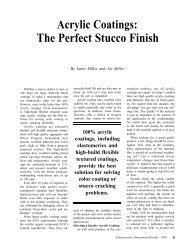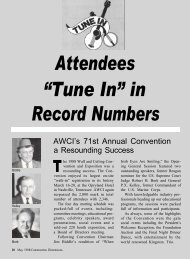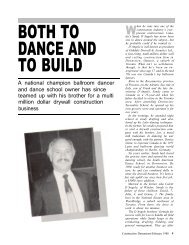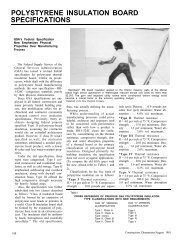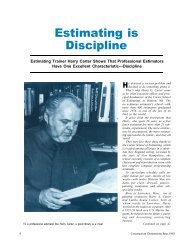Jim Brunemann: An Eye for the Future - AWCI
Jim Brunemann: An Eye for the Future - AWCI
Jim Brunemann: An Eye for the Future - AWCI
You also want an ePaper? Increase the reach of your titles
YUMPU automatically turns print PDFs into web optimized ePapers that Google loves.
JIM BRUNEMANN: <strong>An</strong> <strong>Eye</strong> <strong>for</strong> <strong>the</strong> <strong>Future</strong><br />
Success to This Cincinnati Contractor<br />
is Mixing Innovation With Tough<br />
Minded Management<br />
��<br />
�hile o<strong>the</strong>rs in <strong>the</strong> construction industry are<br />
struggling to hold on to what <strong>the</strong>y have, waiting <strong>for</strong> <strong>the</strong><br />
return of ‘business as usual,’ <strong>Jim</strong> <strong>Brunemann</strong> is pushing<br />
<strong>for</strong>ward—adapting, changing and inventing to<br />
meet <strong>the</strong> demands of today’s market.<br />
<strong>Jim</strong> <strong>Brunemann</strong> is <strong>the</strong> President of R. B.<br />
<strong>Brunemann</strong> and Son, Inc. of Cincinnati, an exciting,<br />
innovative company whose yearly volume reaches well<br />
into <strong>the</strong> $10 million a year range. During <strong>the</strong> last 4<br />
years of <strong>the</strong> so-called recession, <strong>the</strong> company has expanded<br />
to show a net gain of between 20 to 30 percent<br />
in business volume.<br />
<strong>Brunemann</strong> feels <strong>the</strong> reason <strong>for</strong> <strong>the</strong> company’s success<br />
can be attributed to <strong>the</strong> fact that it is geared to<br />
change with <strong>the</strong> times . . . to experiment . . . to diversify<br />
. . . to start trends and not to follow <strong>the</strong>m.<br />
His zest <strong>for</strong> <strong>the</strong> future was inherited from his fa<strong>the</strong>r,<br />
Robert, <strong>the</strong> founder of <strong>the</strong> firm and president until his<br />
retirement in 1960. Robert taught all his sons that in<br />
order to keep ahead of <strong>the</strong> times one must think in <strong>the</strong><br />
third dimension-to visualize what you want to accomplish<br />
be<strong>for</strong>e undertaking <strong>the</strong> task.<br />
<strong>Brunemann</strong> obtained a business management degree<br />
while attending Xavier University and Ohio State<br />
University, be<strong>for</strong>e moving on to graduate courses at<br />
Georgia State University. His strong business<br />
background is easily evident in his construction management<br />
philosophy.<br />
There are a total of five <strong>Brunemann</strong> bro<strong>the</strong>rs working<br />
within <strong>the</strong> firm. Albert, is <strong>the</strong> Executive Vice<br />
President and handles <strong>the</strong> lath and plastering division.<br />
Richard is <strong>the</strong> Vice President and Treasurer and<br />
heads <strong>the</strong> flooring division. Robert is <strong>the</strong> Secretary<br />
and General Superintendent and Roy is a superintendent<br />
of <strong>the</strong> acoustical division.<br />
Always willing to diversify into new market areas,<br />
<strong>the</strong> firm operates seven systems at present, which include:<br />
drywall and moveable partitions, lath & plastering,<br />
flooring, acoustical ceilings, fireproofing and in-<br />
�����������������������
sulation, exterior curtain walls and light gauge steel<br />
framing.<br />
The manufacturing and prefabrication of exterior<br />
curtain wall and steel framing systems has been a love<br />
and pre-occupation of <strong>Jim</strong> <strong>Brunemann</strong> <strong>for</strong> many years<br />
and is an important part in <strong>the</strong> company’s enormous<br />
success. <strong>Brunemann</strong> possesses over 10 patents with<br />
<strong>the</strong> government and has applied <strong>for</strong> several more on<br />
equipment that he has designed and built to per<strong>for</strong>m<br />
specific prefab functions.<br />
His expertise and knowledge of <strong>the</strong> new and exciting<br />
field of light gauge steel framing is held in high esteem<br />
by not only his colleagues in <strong>the</strong> wall and ceiling industry<br />
but by manufacturers and architects alike.<br />
Many area developers and contractors have begun<br />
to rely on R. B. <strong>Brunemann</strong> & Son, Inc. <strong>for</strong> <strong>the</strong> purchase<br />
of preassembled steel panels, which <strong>the</strong> company<br />
manufactures.<br />
With all of this <strong>the</strong> 48 year old <strong>Brunemann</strong> still finds<br />
time <strong>for</strong> his family, which consists of his wife Joan and<br />
<strong>the</strong>ir six children. His two oldest daughters are married<br />
and his third girl, Connie, works <strong>for</strong> <strong>the</strong> company<br />
as a receptionist and secretary. The three boys are all<br />
still in school and are looking <strong>for</strong>ward to working with<br />
<strong>the</strong>ir fa<strong>the</strong>r one day.<br />
When Construction Dimensions first approached<br />
<strong>Jim</strong> <strong>Brunemann</strong> with <strong>the</strong> idea of an interview, he was<br />
hesitant, not wanting to blow his own horn. But as’<br />
soon as he was made aware of <strong>the</strong> fact that this was to<br />
be a steeling framing issue he was more than happy to<br />
help.<br />
DIMENSIONS: <strong>Jim</strong>, has your business management<br />
background aided you in <strong>the</strong> wall and ceiling industry?<br />
BRUNEMANN: Yes, but I feel <strong>the</strong>re is a very<br />
complex inter-relationship between construction<br />
technology and business management, and I feel one<br />
should try to define that relationship as it relates to his<br />
����������<br />
The spectrum of services offered by <strong>Jim</strong><br />
<strong>Brunemann</strong> and his company demands<br />
careful planning and rechecking.<br />
business and its ultimate goals. So often contractors<br />
loose sight of this relationship.<br />
DIMENSIONS: As you see it, what are <strong>the</strong> different<br />
business management divisions:<br />
BRUNEMANN: They are administration, estimating<br />
and engineering, operations, sales and promotion,<br />
marketing and research and development. Operations<br />
is where we make our money. That’s where <strong>the</strong> profits<br />
are realized provided that our flow of equipment and<br />
materials and productivity is at <strong>the</strong> level or better than<br />
we estimated it. But this is not to say that operations is<br />
<strong>the</strong> most important aspect of any business. I would say<br />
that R & D and marketing have probably aided us<br />
more than any o<strong>the</strong>r during this recent down market.<br />
DIMENSIONS: <strong>An</strong>d yet sales, promotion, marketing,<br />
research and development are usually <strong>the</strong> first budget<br />
items to be cut during a recession.<br />
BRUNEMANN: I understand this is true probably<br />
because it doesn’t make sense spending money on a<br />
dead market. But, research and development is important<br />
in developing <strong>the</strong> technique of present product<br />
lines and <strong>the</strong> development of new techniques with new<br />
products.<br />
As we have developed techniques, such as; prefabrication<br />
of steel framing, it was important through<br />
marketing, sales and promotion to exploit our concepts.<br />
This has enabled our business to grow during<br />
<strong>the</strong> down trend. I feel that our industry, because of its<br />
high labor ratio to its sales dollar, can and will develop<br />
<strong>the</strong> product lines and techniques to make it a stronger<br />
industry.<br />
DIMENSIONS: Do you have your own research area?<br />
BRUNEMANN: When we do specific testing of a<br />
product we use several local testing laboratories. We<br />
do, though, have an area in one of our warehouses<br />
designated <strong>for</strong> research and development.<br />
At times, when a particular operation or a new piece<br />
(Continued on Page 20)<br />
��
BRUNEMANN:<br />
(Continued from Page 11)<br />
of equipment needs to be analyzed, we do so in this<br />
area. Each step is recorded on a portable TV camera<br />
so we can review its steps and analyze such things as<br />
time studies and technology.<br />
DIMENSIONS: All your innovative planning and research<br />
is great, but you still have to educate your customers,<br />
don’t you?<br />
BRUNEMANN: Our marketing is directed toward<br />
<strong>the</strong> architect and developer. We went to great extent to<br />
compose an in<strong>for</strong>mative and attractive brochure that<br />
expresses our technique.<br />
Recently we held an Architectural Seminar with a<br />
major steel manufacturer on light gage steel stud framing<br />
<strong>for</strong> more than 50 Architects in our area. From this<br />
seminar we have 6 jobs that are presently being<br />
switched over to light gage steel framing with thin cast<br />
concrete, in lieu of <strong>the</strong> masonry or pre-cast concrete<br />
originally designed. We also have about 5 jobs ranging<br />
from one story to four story <strong>for</strong> light gage steel fram-<br />
ing.<br />
I would say that this success is contributed to Research<br />
and Development, marketing and Sales &<br />
Promotion, along with <strong>the</strong> joint ef<strong>for</strong>ts of Inryco, who<br />
helped put on this seminar.<br />
DIMENSIONS: Your company is heavily committed<br />
to steel framing. Where do you see steel framing as a<br />
market in, let’s say, <strong>the</strong> next 10 years?<br />
BRUNEMANN: It is extremely difficult to run a<br />
marketing analysis in our industry, particularly as a<br />
contractor since we do not have those resources.<br />
But, it is <strong>the</strong> general thinking of steel manufacturers<br />
that steel framing will not reach its total potential <strong>for</strong><br />
15 years. This means that this market is on a steady<br />
increase and will not become level <strong>for</strong> 15 years. I feel<br />
that <strong>the</strong> rise in <strong>the</strong> steel framing industry will be<br />
quicker.<br />
DIMENSIONS: Is <strong>the</strong>re really a steel framing boom?<br />
BRUNEMANN: As I indicated earlier, it has not<br />
reached its peak but it is rising. The present demands<br />
<strong>for</strong> saving energy, better fire rating, and speed of erection<br />
are going to be more demanding in <strong>the</strong> future.<br />
Steel framing is <strong>the</strong> most likely ingredient to meet<br />
those demands.<br />
DIMENSIONS: Over <strong>the</strong> years you’ve gotten <strong>the</strong><br />
reputation of being a pioneer and expert in <strong>the</strong> steel<br />
framing field and in prefabrication. What initially propelled<br />
you into this area?<br />
BRUNEMANN: My fa<strong>the</strong>r was prefabricating with<br />
channel iron and metal lath during <strong>the</strong> depression and<br />
(Continued on Page 26)<br />
��� �����������������������
��<br />
BRUNEMANN:<br />
(Continued from Page 20)<br />
he claimed it saved his business. So through <strong>the</strong> years<br />
we were always looking <strong>for</strong> ways to prefabricate, not<br />
to save our business but to improve our techniques,<br />
productivity, and profit.<br />
Prefabrication of steel framing and curtain wall<br />
seemed an excellent way to make a profit and control<br />
our destiny. Since prefabrication is done within a controlled<br />
environment, it has helped us to produce a quality<br />
product at a faster rate.<br />
DIMENSIONS: Mention prefabrication to <strong>the</strong> public<br />
and visions of assembly lines, mobile homes and cheapness<br />
pop into <strong>the</strong>ir minds. How do you combat this?<br />
BRUNEMANN: For <strong>the</strong> most part, we are not<br />
dealing with a consumer product, but ra<strong>the</strong>r a<br />
technique to produce an end product with better quality<br />
control, and speed of erection.<br />
The prudent architect, <strong>the</strong> developer, or contractor,<br />
once <strong>the</strong> story is told, realizes that he is getting a better<br />
product with many cost savings. You have to realize<br />
that <strong>the</strong>se people are experts and <strong>the</strong>y realize <strong>the</strong> advantages<br />
of prefabrication over stick building.<br />
DIMENSIONS: How much and what kind of help can<br />
a contractor reasonably expect from <strong>the</strong> steel manufacturers?<br />
BRUNEMANN: In my opinion, he can expect fantastic<br />
help. The manufacturers belonging to <strong>the</strong> Metal<br />
Lath/Steel Framing Association not only offer help but<br />
ask you to ask <strong>for</strong> it. These manufacturers have been<br />
exposed, <strong>for</strong> some time, in prefabrication and erection<br />
of steel framing and are willing to assist any sincere<br />
contractor who wants to get into <strong>the</strong> steel framing industry.<br />
DIMENSIONS: In what <strong>for</strong>m does this help come?<br />
BRUNEMANN: I believe <strong>for</strong> <strong>the</strong> most part, manufacturers<br />
are willing to help <strong>the</strong> contractor in <strong>the</strong> design<br />
engineering, drafting, and shop drawings. Some<br />
will also aid in <strong>the</strong> initial planning, figuring and estimating,<br />
although I feel this is a function of <strong>the</strong> contractor.<br />
Nothing would please a manufacturer more than a<br />
sincere call <strong>for</strong> assistance. Some contractors, however,<br />
do not realize <strong>the</strong> benefits of prefabrication. It<br />
<strong>for</strong>ces a contractor to preplan each operation of <strong>the</strong><br />
job. You would be surprised how much money a little<br />
preplanning can save.<br />
DIMENSIONS: Have you had any delivery problems?<br />
BRUNEMANN: For <strong>the</strong> most part, delivery<br />
schedules have never really given us much of a problem.<br />
A manufacturer who can deliver in 3 days is no<br />
better or worse than a manufacturer who delivers in<br />
two weeks, provided he accomplishes what he says he<br />
can do. One must plan accordingly, and problems arrise<br />
only when <strong>the</strong> delivery schedule is not adhered to.<br />
DIMENSIONS: With <strong>the</strong> present cost of steel roughly<br />
equal to wood, will <strong>the</strong> continued steel price increases to<br />
you, and subsequently to <strong>the</strong> owner, take <strong>the</strong> competi-<br />
�����������������������
tive edge away from steel framing?<br />
BRUNEMANN: If one considers wood as <strong>the</strong> only<br />
competitive factor, steel framing on some types of<br />
building is still more economical. Consider <strong>the</strong> fact<br />
that steel stud framing is used on load bearing partitions,<br />
and drywall studs are used on nonload bearing<br />
partitions which in fact are cheaper than wood. With<br />
<strong>the</strong> right combination of this steel framing concept it<br />
has a competitive edge over wood.<br />
The wood industry, of course, uses 2 x 4's throughout.<br />
But wood is not <strong>the</strong> only product that this industry<br />
is competing against. Fire ratings, energy and speed of<br />
erection are also cost saving techniques within this<br />
system. Consider also <strong>the</strong> masonry and pre-cast concrete<br />
industries, against which <strong>the</strong> steel framing can<br />
economically compete.<br />
It might also be well to point out that it took 20-25<br />
years <strong>for</strong> <strong>the</strong> wood industry to develop into what we<br />
see today and I speak specifically of prefabrication.<br />
The technique and development of <strong>the</strong> wood industry<br />
changed drastically over <strong>the</strong>se years.<br />
It is not going to take this long <strong>for</strong> <strong>the</strong> steel framing<br />
industry to develop its technique. I expect its progress<br />
to be at a much more rapid rate.<br />
DIMENSIONS: What steps would you recommend to<br />
a contractor just entering <strong>the</strong> steel framing market?<br />
BRUNEMANN: Many aggressive contractors<br />
have diversified <strong>the</strong>ir business, let’s say from plastering<br />
to ceilings to drywall and so <strong>for</strong>th. Maybe not in<br />
that order, but <strong>the</strong>y did in fact go into o<strong>the</strong>r<br />
businesses. In <strong>the</strong> beginning, I am sure <strong>the</strong>y were not<br />
experts in <strong>the</strong>ir new operations. Making this learning<br />
transition from novice to expert, <strong>the</strong>y apparently were<br />
willing to pay <strong>the</strong> tuition price. I would assume <strong>the</strong>n,<br />
that a contractor should be willing to pay that price to<br />
get his feet wet.<br />
It would seem to me that he might want to build<br />
some mock-up partitions to gain knowledge and develop<br />
a few techniques in order that he may be more<br />
capable of bidding a small steel framing job.<br />
After he initially takes on <strong>the</strong> task of a few small<br />
jobs, I am sure he will develop <strong>the</strong> techniques and<br />
costing necessary, to develop ano<strong>the</strong>r division within<br />
To <strong>Jim</strong> <strong>Brunemann</strong> research and development is <strong>the</strong> key to<br />
future profits.<br />
his company. This is fact, is what he has been doing<br />
<strong>for</strong> some time. Many contractors to whom I have<br />
talked seem to fear shop drawings, welding, prefabrication,<br />
and <strong>the</strong> application of light gage steel framing<br />
structural walls. Aggressive contractors have been facing<br />
<strong>the</strong>se fears all <strong>the</strong>ir construction lives, but have<br />
adapted <strong>the</strong>mselves to those challenges and have successfully<br />
built <strong>the</strong>ir business on diversification.<br />
DIMENSIONS: So basically you suggest first getting<br />
your feet wet?<br />
BRUNEMANN: What o<strong>the</strong>r way is <strong>the</strong>re to do it?<br />
I believe that manufacturers are willing to help <strong>the</strong><br />
contractor if <strong>the</strong> contractor wants to help himself. The<br />
architects have a reasonably good idea on <strong>the</strong><br />
engineering involved.<br />
Also I feel that iaWCC/GDCI can be invaluable in<br />
keeping a contractor headed in <strong>the</strong> right direction. His<br />
initial cost may be a little high in <strong>the</strong> beginning, but<br />
that will go down quickly and profits should go up.<br />
Aggressive contractors are basically innovative<br />
people and it will not take <strong>the</strong>m long to develop <strong>the</strong>ir<br />
technique and improve <strong>the</strong>ir profit picture with light<br />
gage steel framing. �<br />
���������� ��




